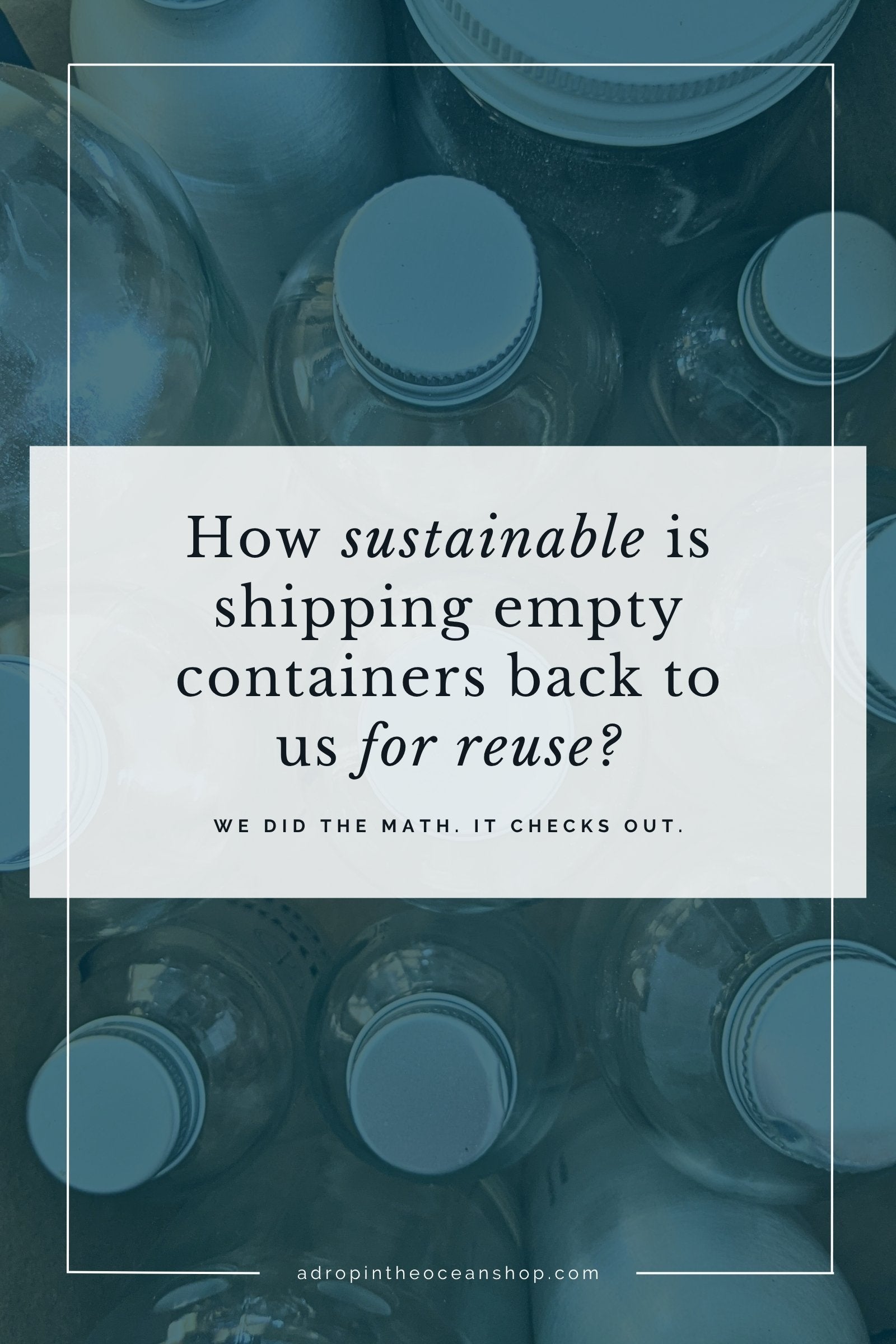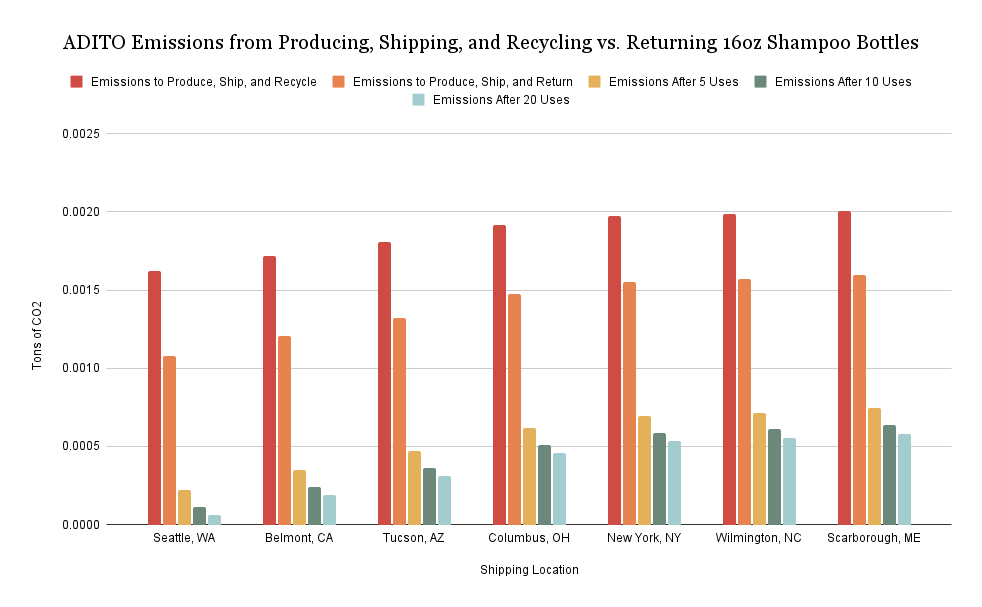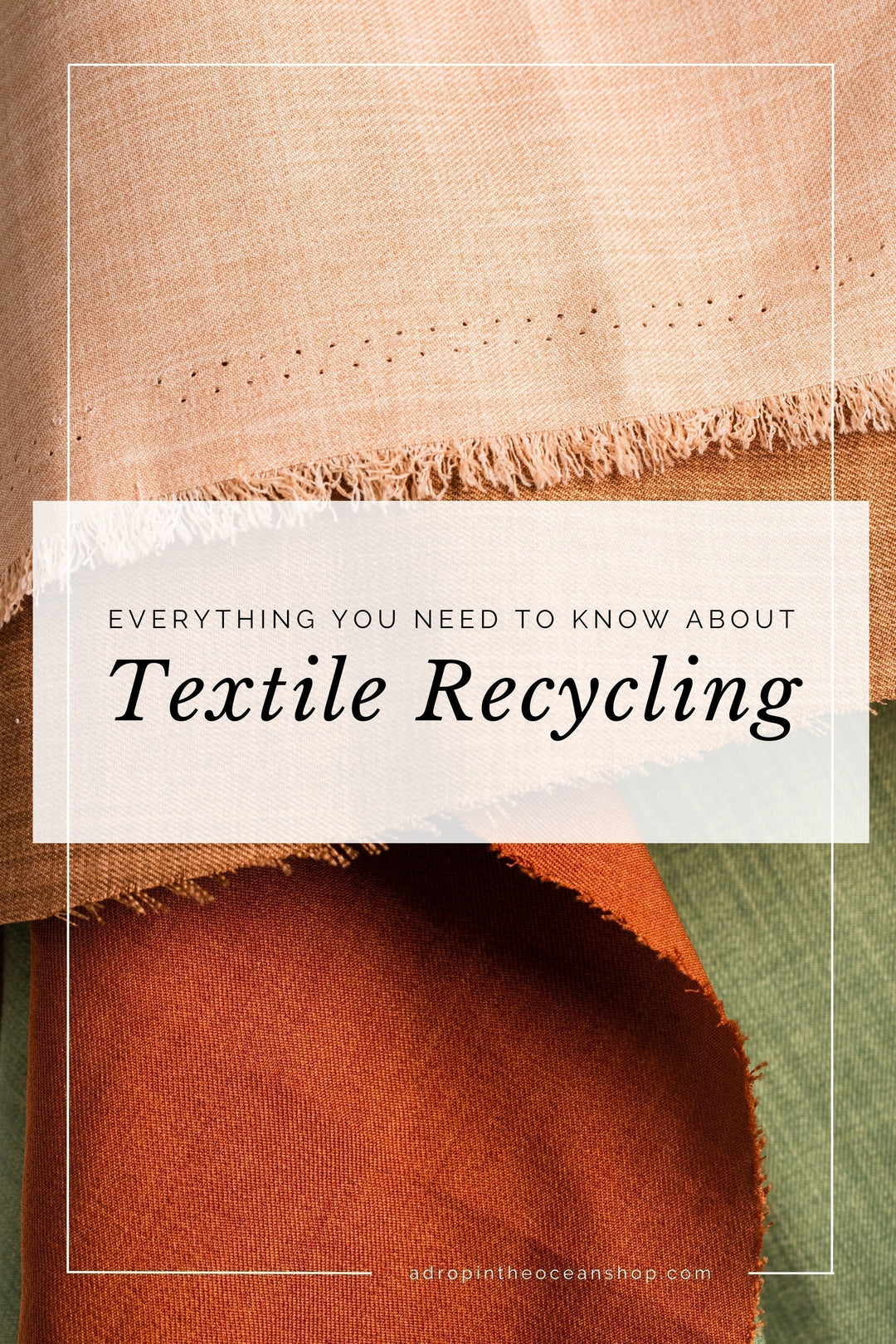Is it actually more sustainable to ship empties back for reuse vs. recycle them locally?

This post first appeared in our weekly Make Waves Mondays email series on May 19, 2025.
Hello friend!
Let’s talk about a question I’ve been asked many a time over the last 6+ years we’ve been in business:
Is it *really* more sustainable to ship empty jars and bottles back to us to reuse rather than just recycling them?
This is a TOTALLY fair question, and one that I’d honestly be surprised if you hadn’t wondered at some point or another.
All of our containers are glass or aluminum, meaning they’re all highly recyclable, so is shipping empties back and forth really the most sustainable option?
Short answer: yes!
Longer answer: let’s dive into it 👇
What’s the carbon footprint of recycling our empty containers?
Okay let’s start with recycling, since that’s kinda the “default” for our society. What are the emissions produced from recycling our empty bottles and jars?
But first, let’s establish some assumptions in these calculations:
-
These calculations assume a 100% recycling rate - meaning that every single jar and every single bottle is recycled back into a new jar or bottle. As you likely already know, this isn’t how the world actually works (for example, only about 25% of glass is actually recycled). But, for simplicity’s sake, we’re gonna go with it.
-
I really, really tried to find a full breakdown of emissions from the actual recycling process (such as “for every 1kg of glass that’s recycled, X kilograms of carbon dioxide are emitted, and that process includes XYZ with an end result of ABC), but…alas…ya girl came up empty. So instead, our numbers here are calculated based on “emissions saved by recycling.” I’ll explain this more when we get into it.
-
As you probably know, in true data nerd fashion, I can get REAL into the weeds with numbers 😅 So to keep myself relatively on track, I did these calculations for two of our best-selling products - a 64oz jar of laundry detergent and a 16oz bottle of shampoo. I chose these two products with intention so as to represent our heaviest refillable and our lightest refillable.
Now that we’re all on board with the assumptions, let’s get into some emissions!
Recycling Glass
Okay. SO.
Recycling one ton of glass saves about 0.1667 tons of CO2, and producing one ton of glass emits about three tons of CO2.
So taking these two numbers together, we can say that recycling one ton of glass back into new glass items emits about 2.5 tons of CO2 (3 tons x (1 - 0.1667)).
If one of our 64oz glass jars weighs 0.000822 tons (26.3oz), that means that recycling one jar into a new jar emits about 0.00186 tons of CO2, which equates to about 4.7 miles driven in an average passenger car.
That’s not a ton (pun intended 😉), and I’m sure many would agree that’s not a bad number!
But we’re not quite done with recycling yet.
Let’s take a look at the emissions from recycling our aluminum bottles.
Recycling Aluminum
Recycling aluminum is an incredibly efficient process — saving about a whopping 93.8% of emissions compared to making new.
So what does that equate to in terms of actual CO2 emissions?
Producing new aluminum products is actually much more intensive than producing glass. For every one ton of aluminum produced, 15.1 tons of CO2 are emitted.
So just like we did with glass, taking these two numbers together, recycling one ton of aluminum back into new aluminum emits about 0.94 tons of CO2 (15.1 tons x (1 - 0.062)).
If one of our 16oz aluminum bottles weighs 2.5oz, that means that recycling one bottle into a new bottle emits about 0.00007 tons of CO2, or just 0.18 miles (950 feet) driven in an average passenger car.
And now at this point I KNOW that you’re looking at these numbers going, “Krystina…there’s no freaking WAY that shipping an empty container (especially an aluminum bottle) back to you is more sustainable than recycling it!”
But…is it…?
What’s the carbon footprint of shipping our containers to you and back to us?
We have EcoWarriors all over the country, so rather than choosing a city at random and doing some calculations for just that one city, I took a look at the cities that we ship to most regularly, and chose a few that are spread out across the country to see how the numbers varied, and if there’s a cutoff distance for where recycling might be the more sustainable option.
The cities we’ll be looking at today are (in order of one-way distance from our HQ in Tacoma):
-
Seattle, WA (34.4 miles)
-
Belmont, CA (798 miles)
-
Tucson, AZ (1,517 miles)
-
Columbus, OH (2,399 miles)
-
New York, NY (2,866 miles)
-
Wilmington, NC (2,989 miles)
-
Scarborough, ME (3,153 miles)
And to do our calculations, we’ll be using the emissions equation from the Environmental Defense Fund’s Green Freight Handbook:
Greenhouse Gas Emissions = D x W x EF
where D = the distance the shipment has traveled (in miles), W = the weight of the shipment (in tons), and EF = the mode of transportation’s emissions factor.
Because we ship all of our packages with USPS Ground Advantage shipping, the emissions factor for our calculation is 161.8.
We also can’t ignore the box your order is being shipped in. We’ll do a bit more with the box piece later, but in this section, we’re going to add the weight of an 8”x8”x8” cardboard box to our shipping emissions calculations.
Okay, let’s get into it!
Shipping Glass
Okay so let’s start with shipping a 64oz jar of laundry detergent to Seattle (our heaviest product to our nearest neighbor).
Our emissions calculation would be: (34.4 miles) x (0.003013 tons) x (161.8) where 0.003013 tons is the sum of the weight of a full jar of detergent (90.3oz) plus the weight of the 8x8x8 box (6.1oz).
Therefore, the emissions from shipping a 64oz jar of detergent to Seattle is 0.0000157 tons of CO2 — the equivalent of driving about 0.04 miles (211 feet) in an average passenger car.
I bet our post about the sustainability of online shopping versus in-person is starting to make a bit more sense now 😉
Now what about to return that jar?
The only thing that changes in our emissions calculation here would be the weight of the package, which drops down to 0.001013 tons (32.4oz) for an empty 64oz jar and the cardboard box.
So with that new weight, the emissions to return an empty 64oz laundry detergent jar to us from Seattle is just 0.0000056 tons of CO2 — or the equivalent of driving about 0.014 miles (74 feet) in an average passenger car.
➡️ All of this means that in total, shipping a 64oz jar of laundry detergent to Seattle and then shipping the empty jar back to us here in Tacoma clocks in at just 0.000022 tons of CO2 — the equivalent of driving just 0.056 miles (296 feet) in an average passenger car.
Now…let’s do those same calculations for shipping a 64oz jar of detergent to Scarborough, ME (our heaviest product to our furthest EcoWarriors).
-
Emissions to Maine = (3,153 miles) x (0.003013 tons) x (161.8) = 0.001537 tons of CO2 = 3.9 miles driven in an average passenger vehicle
-
Emissions to Return to Tacoma = (3,153 miles) x (0.001013 tons) x (161.8) = 0.000517 tons of CO2 = 1.3 miles driven in an average passenger vehicle
-
TOTAL Emissions = 0.002053 tons of CO2 = 5.2 miles in average passenger vehicle
➡️ So to ship a 64oz jar of laundry detergent to Scarborough, Maine and return the empty jar to us in Tacoma only emits about 0.002053 tons of CO2, or the equivalent of driving just 5.2 miles in an average passenger vehicle.
⚡ Put another way, shipping our heaviest product to the literal opposite end of the country emits 25% less carbon dioxide than for me to drive to and from the grocery store that’s literally on the same street as me.
And rather than bore you with more data analysis, here’s a handy dandy spreadsheet for the other cities on the list 😄

Shipping Aluminum
Okay so we already know that shipping our heaviest product isn’t emitting that much carbon dioxide into our atmosphere, so we can probably assume that shipping one of our lightest products is emitting even less, but we’re not about assumptions around here (except when we’re making them intentionally to do math lol).
So let’s look at the emissions from shipping a 16oz bottle of shampoo to Seattle (our lightest product to our nearest neighbor).
-
A 16oz bottle of shampoo weighs in at 0.000578 tons (18.5oz), and an empty 16oz aluminum bottle weighs in at 0.000078 tons (2.5oz).
-
Emissions to Seattle = (34.4 miles) x (0.000769 tons) x (161.8) = 0.0000043 tons of CO2 = 0.01 miles (58 feet) driven in an average passenger vehicle
-
Emissions to Return to Tacoma = (34.4 miles) x (0.000269 tons) x (161.8) = 0.0000015 tons of CO2 = 0.004 miles (21 feet) driven in average passenger vehicle
-
TOTAL Emissions = 0.0000058 tons of CO2 = 0.015 miles (79 feet) driven in average passenger vehicle
➡️ So to ship a 16oz bottle of shampoo to Seattle and return the empty bottle to us in Tacoma only emits about 0.0000058 tons of CO2, or the equivalent of driving just 79 feet in an average passenger vehicle.
Negligible.
But what about Scarborough, Maine? Does the low impact still hold up when we’re shipping our lightest product to our furthest EcoWarriors?
-
Emissions to Maine = (3,153 miles) x (0.000769 tons) x (161.8) = 0.000392 tons of CO2 = 0.998 miles driven in an average passenger vehicle
-
Emissions to Return to Tacoma = (3,153 miles) x (0.000269 tons) x (161.8) = 0.000137 tons of CO2 = 0.35 miles driven in an average passenger vehicle
-
TOTAL Emissions = 0.000529 tons of CO2 = 1.3 miles in average passenger vehicle
➡️ To ship a 16oz bottle of shampoo to Scarborough, Maine and return the empty bottle to us in Tacoma only emits about 0.000529 tons of CO2, or the equivalent of driving just 1.3 miles in an average passenger vehicle.
I just have to pause for a moment and reflect on the fact that shipping a bottle of shampoo across the country more than 3,000 miles has the same impact as driving less than two miles.
That truly feels so insane, even as someone who’s done a ton of research on the sustainability of shipping products, but in many ways it does still make sense.
USPS is already coming to my home and yours 6 days a week.
They’re driving trucks across the country every day, whether we’re shipping or not.
By us adding your orders to their already-existing systems, the only emissions we’re adding are from the weight of your order.
We’re not putting more trucks on the road, we’re not using Priority Mail and flying your orders to you, we’re making use of streamlined, ground transportation systems that are already coming to your front door.
And I think that’s really dang cool.
But before we move on, I’m not just gonna leave you hanging with the rest of the cities in our calculations between Seattle and Scarborough…

Putting it all together…
Okay so now that we’ve established that sending your empty A Drop in the Ocean bottles and jars back to us to reuse does actually produce less greenhouse gas emissions than recycling them, let’s take it just one step further and put it allllllll together — including the emissions cost of making the bottles and jars in the first place.
Glass: If making one ton of glass produces about three tons of carbon dioxide emissions, as we established above, and one of our 64oz glass laundry detergent jars weighs 0.000822 tons (26.3oz), that means the emissions from producing that jar initially are about 0.00224 tons of CO2 — or about the same emissions as driving 5.7 miles in an average passenger vehicle.
Aluminum: If making one ton of aluminum produces about 15.1 tons of carbon dioxide emissions, and one of our 16oz aluminum shampoo bottles weighs 0.000078 tons (2.5oz), that means the emissions from producing that bottle initially are about 0.00107 tons of CO2 — or about the same emissions as driving 2.7 miles in an average passenger vehicle.
These aren’t insignificant numbers, so we don’t want to exclude them from our analysis.
And let’s also remember that we’re not just returning the empties to sit on a shelf forever.
All of those empties get washed, sanitized, and refilled over and over and over again.
So even though, yes, returning that empty jar even just once does produce less emissions than recycling it, reusing that jar multiple times means that the per-use impact of that jar gets less and less and less.
So to pull everything together, let’s take a look at the emissions from producing, shipping, recycling, and returning over time.
Laundry Detergent Jars
By returning empty ADITO laundry detergent jars for reuse, depending on where you live, you can save anywhere from 29.9% to 50.9% of the CO2 emissions that would be produced from the recycling process instead.
The percentage decreases the further from Tacoma you are, but even that 29.9% in Scarborough, Maine is substantial.
Then, after just 5 reuses, the emissions drop substantially.
If you’re in Seattle, returning and reusing a 64oz laundry detergent jar five times brings the per-use emissions to just 0.000470 tons of CO2, or 1.2 miles driven in an average passenger vehicle.
If instead you recycled all of those jars, after five jars the emissions would total 0.023 tons of CO2 — or 58.6 miles driven in an average passenger vehicle.
After 20 reuses, your per-use emissions drop all the way down to 0.000134 tons of CO2, or just 0.34 miles.

NOW. Your next question is probably, “Yeah but Krystina…are you ACTUALLY reusing those jars 20+ times??”
And the answer, friend, is yes we are.
On average, our EcoWarriors order from us every 3 months.
As of today, we’ve been in business for 6 years and 3 months. That’s 24 3-month cycles.
And, yes, we do still have jars in circulation from that very first year.
How do I know? Oh I would LOVE to tell you.
Due to supply chain issues early in 2020, we switched our laundry detergent jar style, and we also changed our container labels around that same time. To this day, we still receive and reuse containers from before those changes were made.
It’s rough math, sure, but reusing a jar 20+ times is not outside of our realm, and over time it’s only going to become more and more realistic.
Liquid Shampoo Bottles
When we look at the emissions from our aluminum shampoo bottles, the trend follows exactly the same as the detergent jars.
Depending on where you live, the emissions from producing, shipping, and returning an empty 16oz shampoo bottle to us can save anywhere from 20.4% to 33.3% of the emissions that would be produced from recycling the bottle instead.
And, again, the per-use emissions drop substantially the more the bottles are returned and reused.

It’s also important to note here that these emissions calculations DO include the emissions from shipping the cardboard box back and forth and recycling it, but DO NOT include the emissions from producing the box.
I chose not to include the production emissions since we utilize secondhand boxes for about 92% of our orders, so by the time we use them, they’re already in the “reuse” phase of their life.
So in summary…
I know that this was A LOT of numbers and data and your head might be spinning a bit 🤓
So here’s the important stuff ya gotta know:
-
No matter where you live in the US, recycling A Drop in the Ocean bottles and jars emits more carbon dioxide than returning those empty bottles and jars back to us to reuse.
-
The more each bottle and jar gets reused, the less emissions are produced per use.
-
Even if you live on the opposite side of the country, it’s still more sustainable to order from A Drop in the Ocean than drive down the street to your big box store to get your everyday essentials.
Everything we do around here is backed by science (and math!) and I know that this blog post was long overdue, but I do hope that you enjoyed nerding out over numbers reading it as I did writing it 😄
I would absolutely LOVE to hear your thoughts on all of this, too.
Were you surprised by any of it?
Is it about what you were expecting?
Was it too many numbers and you zoned out halfway through? 😅
I wanna know! Comment below and let’s chat about it!
I’ll “see” you again next week, friend 💙









Leave a comment